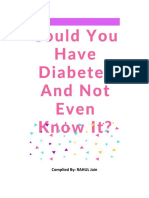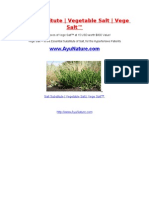Carrot Man: A Case of Excessive Beta-Carotene Ingestion
Carrot Man: A Case of Excessive Beta-Carotene Ingestion
Uploaded by
teste testeCopyright:
Available Formats
Carrot Man: A Case of Excessive Beta-Carotene Ingestion
Carrot Man: A Case of Excessive Beta-Carotene Ingestion
Uploaded by
teste testeOriginal Title
Copyright
Available Formats
Share this document
Did you find this document useful?
Is this content inappropriate?
Copyright:
Available Formats
Carrot Man: A Case of Excessive Beta-Carotene Ingestion
Carrot Man: A Case of Excessive Beta-Carotene Ingestion
Uploaded by
teste testeCopyright:
Available Formats
CASE REPORT
Carrot Man: A Case of Excessive Beta-Carotene Ingestion
Randy A. Sansone, MD1,2,3* ABSTRACT
In this case report, the authors describe a
to facilitate his dieting effort. The patient
was diagnosed with constipation, hyper-
Lori A. Sansone, MD4 48-year-old male who complained to his carotinemia, and possible vitamin A tox-
primary care physician of abdominal dis- icity. Following the cessation of excessive
comfort and yellow/orange skin discolor- carrot ingestion, his liver enzymes nor-
ation. Physical examination was normal malized within 1 month. V C 2012 by Wiley
except for some mild mid-abdominal dis- Periodicals, Inc.
comfort (no observed skin color changes).
An abdominal CT scan indicated a colon Keywords: beta-carotene; carrots; diet-
that was full of stool. Laboratory studies ing; liver enzymes
indicated elevated liver enzymes. Upon
further questioning, the patient reported
ingesting 6–7 pounds of carrots per week (Int J Eat Disord 2012; 00:000–000)
ficulty in doing so. In the following case report, the
Introduction
authors describe a previously obese adult male
Overweight, obesity, and dieting behaviors seem to who disclosed an unusual approach to dieting—an
be integral themes in the fabric of American soci- approach that resulted in several unexpected phys-
ety. For example, according to the US National ical findings.
Health and Nutrition Examination Survey in 2003–
2004, 17% of children and adolescents were over-
weight and 32% of adults were obese.1 In addition,
using a survey format in a randomized sample of Case Report
over 38,000 college students, investigators found
that 50% of respondents were attempting to diet.2 Mr. C. was a 48-year-old white male who presented
Finally, in a cross-sectional population-based tele- to his family physician for the evaluation of a swol-
phone survey, 15.2% of adults reported having used len abdomen and periodic yellow-orange discolor-
a weight-loss supplement—8.7% in the past year.3 ation of his skin. In support of his concerns, the
In the context of these statistics, obesity remains patient indicated that others had commented
contributory for a number of medical morbidities about his odd skin color. Symptoms had been pres-
(e.g., diabetes, high blood pressure, cardiovascular ent for 3–4 months. He denied nausea, changes in
disease, joint stress, hyperlipidemia), and abdomi- appetite, vomiting, diarrhea, constipation, melena,
nal obesity has been shown to significantly relate or hematochezia. Mr. C. reported some mild, inter-
to cardiovascular mortality.4 Therefore, attempts to mittent, mid-abdominal discomfort. The patient
lose weight are oftentimes justified, despite the dif- denied any alcohol or drug use. Mr. C. reported
that, during the previous year, he had successfully
lost 100 pounds ‘‘without much effort.’’
Accepted 11 February 2012
At the time of the initial evaluation, Mr. C. was
The views and opinions expressed in this article are those of the
authors and do not reflect the official policy or position of the US 50 8@ and 152 pounds (BMI 5 23.1). On physical
Air Force, Department of Defense, or US Government. examination, vital signs were normal. The patient
*Correspondence to: Dr. Randy A. Sansone, Sycamore Primary appeared well nourished and developed, and in
Care Center, 2115 Leiter Road, Miamisburg, OH 45342.
no acute distress. Overall skin color appeared nor-
E-mail: Randy.sansone@khnetwork.org
1
Department of Psychiatry, Wright State University School of mal and there was no evidence of jaundice or
Medicine, Dayton, Ohio icterus. The cardiorespiratory and neurological
2
Department of Internal Medicine, Wright State University examinations were normal. Examination of the
School of Medicine, Dayton, Ohio
3 abdomen confirmed some distention but no ten-
Department of Psychiatry, Kettering Medical Center, Kettering,
Ohio derness.
4
Department of Primary Care, Wright-Patterson Air Force Base, In the aftermath of the initial examination, the
Dayton, Ohio
patient’s primary care physician ordered a compre-
Published online in Wiley Online Library
(wileyonlinelibrary.com). DOI: 10.1002/eat.22015 hensive metabolic panel as well as a CT scan of the
VC 2012 Wiley Periodicals, Inc. abdomen and pelvis to evaluate for the presence of
International Journal of Eating Disorders 00:0 000–000 2012 1
BETA-CAROTENE
a mass. The CT results indicated normal findings not affected, as in jaundice (an indicator of he-
with the exception of, ‘‘stool. . . throughout the patic disease).
entire colon. . . raising the concern for constipa- In addition to discoloration of the skin, Mr. C. had
tion.’’ The laboratory studies, including albumin an elevation in liver enzymes. On rare occasion, ele-
and protein, were normal except for an elevation in vated levels of beta-carotene have been associated
two liver enzymes: alanine aminotransferase (ALT; with changes in the livers of humans.8 These types
98 U/L; normal range 24–63 U/L) and lactate de- of changes have also been empirically documented
hydrogenase (LDH; 260 U/L; normal range 100– in animal studies.9,10
190 U/L). Despite the conversion of beta-carotene to vita-
During a follow-up appointment approximately min A, excessive ingestion of beta-carotene is not
2 weeks later, the patient disclosed eating 6–7 typically associated with vitamin A toxicity. How-
pounds of carrots per week for a period of months. ever, this patient may have also had some mild
Due to his skin discoloration and the elevation in vitamin A toxicity due to high exposure over a
liver enzymes without other contributory etiologies lengthy period of time. A single 7½ inch carrot has
(e.g., hepatic disease), the patient was diagnosed 8,666 IU of vitamin A, which is nearly twice the
with hypercarotinemia, possible hypervitaminosis daily value or recommended daily allowance. More
A, and constipation. The patient was advised to than three carrots per day is likely to saturate the
curtail his excessive ingestion of carrots. One body’s ability to store vitamin A. While acute toxic-
month after the initial evaluation, follow-up liver ity is unlikely (i.e., a single dose of more than
enzyme studies were normal. 660,000 IU), mild chronic toxicity (10 times the
daily values) may have been present. Signs and
symptoms of chronic vitamin A toxicity include dry
skin, nausea, headache, fatigue, irritability, hepato-
Discussion megaly, and alopecia. In some cases, hepatotoxicity
may lead to cirrhosis. Symptoms possibly related to
The use of carrots to aid in dieting efforts has been vitamin A toxicity in this patient were abdominal
previously recognized and documented by clini- discomfort (possibly also due to constipation) and
cians in the field of eating disorders.5,6 For exam- mild liver enzyme elevation.
ple, in an Italian study, the prevalence of caroteno-
derma (i.e., yellow-orange discoloration of the skin
due to beta carotene) was 21% in a consecutive
sample of 24 patients with eating disorders.7 How- Conclusion
ever, the prevalence rate in the US is far lower and
the presented case is somewhat unusual in that the Dieters remain creative in their attempts to lose
subject was a middle-aged previously obese male weight. In this case, the excessive ingestion of
who also evidenced an associated rare elevation in carrots was the elected dieting method. While
liver enzymes. hypercarotinemia has been referred to as a marker
Beta-carotene is a constituent of carrots as well for disordered eating,11 it may also occur in routine
as other fruits and vegetables (e.g., squash, canta- dieters. To our awareness, this behavior and symp-
loupe, pumpkin, sweet potatoes). It is the most tomatic manifestation has not been reported in a
common carotenoid in the normal human diet. noneating-disordered individual. Clinicians need
Beta-carotene is also called ‘‘provitamin A’’ because to be aware of the possible excessive ingestion of
it consists of two molecules of vitamin A, which carrots, particularly in the presence of localized
become hydrolyzed and released during excursion yellow-orange skin changes in the nasolabial folds,
through the gastrointestinal tract. There is no rec- palms of the hands, and soles of the feet.
ommended daily allowance for beta-carotene.
Excessive ingestion of beta-carotene may cause
an orange-yellow discoloration of the skin (partic-
ularly in the stratum corneum), sweat, and
References
sebum. The discoloration is most noted in areas
of potential skin perspiration, such as the nasola- 1. Ogden CL, Carroll MD, Curtin LR, McDowell MA, Tabak CJ, Flegal
KM. Prevalence of overweight and obesity in the United States,
bial folds, palms of the hands, and soles of the
1999–2004. JAMA 2006;295:1549–1555.
feet. (This may explain why the patient was not 2. Wharton CM, Adams T, Hampl JS. Weight loss practices and
evidencing overt diffuse changes in skin color at body weight perceptions among US college students. J Am Coll
the time of the initial evaluation.) The sclerae are Health 2008;56:579–584.
2 International Journal of Eating Disorders 00:0 000–000 2012
SANSONE AND SANSONE
3. Blanck HM, Serdula MK, Gillespie C, Galuska DA, Sharpe PA, 7. Strumia R, Varotti E, Manzato E, Gualandi M. Skin signs in ano-
Conway JM, et al. Use of nonprescription dietary supplements rexia nervosa. Dermatol 2001;203:314–317.
for weight loss is common among Americans. J Am Diet Assoc 8. Shoenfeld Y, Shaklai M, Ben-Baruch N, Hirschorn M, Pinkhaus
2007;107:441–447. J. Neutropenia induced by hypercarotenaemia. Lancet 1982;1:
4. Zhang C, Rexrode KM, van Dam RM, Li TY, Hu FB. Abdominal 1245.
obesity and the risk of all-cause, cardiovascular, and cancer 9. Heywood R, Palmer AK, Gregson RL, Hummler H. The toxicity of
mortality: Sixteen years of follow-up in US women. Circulation beta-carotene. Toxicology 1985;36:91–100.
2008;117:1658–1667. 10. Ni R, Leo MA, Zhao J, Lieber CS. Toxicity of beta-carotene and
5. Claudius K, Wissler K, Warnke A, Brocker EB. A ‘‘yellow’’ girl. its exacerbation by acetaldehyde in HepG2 cells. Alcohol Alco-
Hypercarotenaemia in anorexia nervosa. J Dtsch Dermatol Ges hol 2001;36:281–285.
2005;3:559–560. 11. Tung EE, Drage LA, Ghosh AK. Carotenoderma and hypercarote-
6. Laxenaire M, Westphal C, Witkowski P. Dysorexias in adoles- namia: Markers for disordered eating habits. J Eur Acad Derma-
cence. Psychol Med 1989;21:1377–1380. tol Venereol 2006;20:1147–1148.
International Journal of Eating Disorders 00:0 000–000 2012 3
You might also like
- The Subtle Art of Not Giving a F*ck: A Counterintuitive Approach to Living a Good LifeFrom EverandThe Subtle Art of Not Giving a F*ck: A Counterintuitive Approach to Living a Good LifeRating: 4 out of 5 stars4/5 (5978)
- The Gifts of Imperfection: Let Go of Who You Think You're Supposed to Be and Embrace Who You AreFrom EverandThe Gifts of Imperfection: Let Go of Who You Think You're Supposed to Be and Embrace Who You AreRating: 4 out of 5 stars4/5 (1111)
- Never Split the Difference: Negotiating As If Your Life Depended On ItFrom EverandNever Split the Difference: Negotiating As If Your Life Depended On ItRating: 4.5 out of 5 stars4.5/5 (896)
- Hidden Figures: The American Dream and the Untold Story of the Black Women Mathematicians Who Helped Win the Space RaceFrom EverandHidden Figures: The American Dream and the Untold Story of the Black Women Mathematicians Who Helped Win the Space RaceRating: 4 out of 5 stars4/5 (932)
- Grit: The Power of Passion and PerseveranceFrom EverandGrit: The Power of Passion and PerseveranceRating: 4 out of 5 stars4/5 (619)
- Shoe Dog: A Memoir by the Creator of NikeFrom EverandShoe Dog: A Memoir by the Creator of NikeRating: 4.5 out of 5 stars4.5/5 (546)
- The Hard Thing About Hard Things: Building a Business When There Are No Easy AnswersFrom EverandThe Hard Thing About Hard Things: Building a Business When There Are No Easy AnswersRating: 4.5 out of 5 stars4.5/5 (356)
- Her Body and Other Parties: StoriesFrom EverandHer Body and Other Parties: StoriesRating: 4 out of 5 stars4/5 (831)
- Elon Musk: Tesla, SpaceX, and the Quest for a Fantastic FutureFrom EverandElon Musk: Tesla, SpaceX, and the Quest for a Fantastic FutureRating: 4.5 out of 5 stars4.5/5 (476)
- The Emperor of All Maladies: A Biography of CancerFrom EverandThe Emperor of All Maladies: A Biography of CancerRating: 4.5 out of 5 stars4.5/5 (275)
- The Little Book of Hygge: Danish Secrets to Happy LivingFrom EverandThe Little Book of Hygge: Danish Secrets to Happy LivingRating: 3.5 out of 5 stars3.5/5 (424)
- The World Is Flat 3.0: A Brief History of the Twenty-first CenturyFrom EverandThe World Is Flat 3.0: A Brief History of the Twenty-first CenturyRating: 3.5 out of 5 stars3.5/5 (2272)
- The Yellow House: A Memoir (2019 National Book Award Winner)From EverandThe Yellow House: A Memoir (2019 National Book Award Winner)Rating: 4 out of 5 stars4/5 (99)
- Devil in the Grove: Thurgood Marshall, the Groveland Boys, and the Dawn of a New AmericaFrom EverandDevil in the Grove: Thurgood Marshall, the Groveland Boys, and the Dawn of a New AmericaRating: 4.5 out of 5 stars4.5/5 (270)
- The Sympathizer: A Novel (Pulitzer Prize for Fiction)From EverandThe Sympathizer: A Novel (Pulitzer Prize for Fiction)Rating: 4.5 out of 5 stars4.5/5 (125)
- Team of Rivals: The Political Genius of Abraham LincolnFrom EverandTeam of Rivals: The Political Genius of Abraham LincolnRating: 4.5 out of 5 stars4.5/5 (235)
- A Heartbreaking Work Of Staggering Genius: A Memoir Based on a True StoryFrom EverandA Heartbreaking Work Of Staggering Genius: A Memoir Based on a True StoryRating: 3.5 out of 5 stars3.5/5 (232)
- On Fire: The (Burning) Case for a Green New DealFrom EverandOn Fire: The (Burning) Case for a Green New DealRating: 4 out of 5 stars4/5 (75)
- The Unwinding: An Inner History of the New AmericaFrom EverandThe Unwinding: An Inner History of the New AmericaRating: 4 out of 5 stars4/5 (45)
- Sabrina's Brochure: Mariana Burca Allstaff Training ConsultantsDocument4 pagesSabrina's Brochure: Mariana Burca Allstaff Training ConsultantsIrina DumitrescuNo ratings yet
- Mcdonalds Situation AnalysisDocument30 pagesMcdonalds Situation AnalysisSehar AzharNo ratings yet
- Case Study On CVADocument34 pagesCase Study On CVAGimcy Dela Fuente50% (2)
- Topic 12: Digestive System: Bhs105 Anatomy & PhysiologyDocument34 pagesTopic 12: Digestive System: Bhs105 Anatomy & PhysiologyZakiahNo ratings yet
- Could You Have Diabetes and Not Even Know ItDocument23 pagesCould You Have Diabetes and Not Even Know Itsnapel itNo ratings yet
- The Health Benefits of BananasDocument4 pagesThe Health Benefits of BananasVijay BhanNo ratings yet
- Dietary Assessment Methods in Nutrition EpidemiologyDocument14 pagesDietary Assessment Methods in Nutrition EpidemiologyArMadea De'aMra100% (1)
- MetaboTrim PH PIPDocument2 pagesMetaboTrim PH PIPYeth FolloscoNo ratings yet
- OSCE ExercisesDocument4 pagesOSCE ExercisesReviewer EditorNo ratings yet
- Your Profile Information Wellness InformationDocument4 pagesYour Profile Information Wellness InformationWes BlackNo ratings yet
- Research Paper Final ColorDocument12 pagesResearch Paper Final Colorapi-359161098No ratings yet
- Physical AssessmentDocument12 pagesPhysical Assessmentteslimolakunleraji100% (1)
- Diabetes Tests - CDCDocument3 pagesDiabetes Tests - CDCxilcomNo ratings yet
- Food MattersDocument4 pagesFood Mattersapi-254020111No ratings yet
- Yoga y AyurvedaDocument50 pagesYoga y AyurvedaManuel100% (3)
- Annotated Bib Final SHDocument8 pagesAnnotated Bib Final SHapi-296682699No ratings yet
- 2006 Drug Trend ReportDocument49 pages2006 Drug Trend ReportkmeriemNo ratings yet
- Intermittent FastingDocument8 pagesIntermittent FastingChicaiza Tituana JhonnNo ratings yet
- BSA Personal - Fitness WorksheetDocument12 pagesBSA Personal - Fitness WorksheetAundrea Marie ParkerNo ratings yet
- Salt Substitute - Vege Salt - Vegetable Salt - AyuNatureDocument6 pagesSalt Substitute - Vege Salt - Vegetable Salt - AyuNatureAyuNatureNo ratings yet
- Elc501 - English For Critical Academic ReadingDocument4 pagesElc501 - English For Critical Academic ReadingatiqahNo ratings yet
- Human Milk Nutrient Composition in The United States: Current Knowledge, Challenges, and Research NeedsDocument18 pagesHuman Milk Nutrient Composition in The United States: Current Knowledge, Challenges, and Research NeedsRizqi MultazamNo ratings yet
- SERBAN ANCUTA NICOLETA - ProjectDocument7 pagesSERBAN ANCUTA NICOLETA - ProjectSoare Ancuta-NicoletaNo ratings yet
- Nursing Care Plan Hypertension - Hypertension - Blood PressureDocument1 pageNursing Care Plan Hypertension - Hypertension - Blood PressureElay PedrosoNo ratings yet
- Eating DisorderDocument13 pagesEating DisorderSandhiya K100% (1)
- StrongLifts 5x5 - The Simplest Workout To Get StrongerDocument39 pagesStrongLifts 5x5 - The Simplest Workout To Get Strongersjeyarajah21100% (1)
- Flip Chart Lesson PlanDocument3 pagesFlip Chart Lesson Planapi-231156895No ratings yet
- Ingredients: o o o o o o o oDocument11 pagesIngredients: o o o o o o o osupergirl131No ratings yet
- Sinas: PNP To Resume BMI Monitoring To Ensure No Cop Is ObeseDocument2 pagesSinas: PNP To Resume BMI Monitoring To Ensure No Cop Is Obesenut_crackreNo ratings yet
- Optimising Mealtime Insulin DosingDocument43 pagesOptimising Mealtime Insulin DosingVera SimilarNo ratings yet






































































